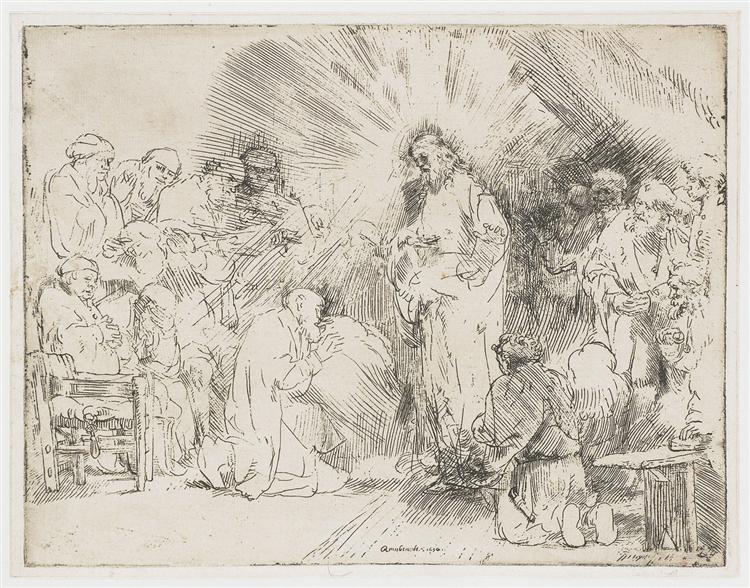Tanım
1656'da Rembrandt tarafından boyanan "Mesih Havarilere Görünen" çalışması, sadece sanatçının yeteneğini değil, aynı zamanda üretken kariyeri boyunca araştırdığı temaların karmaşıklığını da kapsıyor. Bu resim, duygu, ışık ve gölgenin görsel anlatımda önemli bir rol oynadığı barok sanat bağlamının bir parçasıdır. Bu çalışmada Rembrandt, ilahi vahiy ve insan şüphesini simgeleyen, ışık ve karanlık arasındaki etkileşimde kendini mükemmelleştiren ve gösteren bir teknik olan Chiaroscuro'yu ustaca kullanıyor.
Çalışmanın bileşimi, tuvalin merkezinde neredeyse doğaüstü bir parlaklık ile ortaya çıkan Mesih figürüne odaklanmıştır. Onun varlığı, kasvetli çevrenin aksine parlıyor, şaşkınlık ve karışıklık durumunda olan havarilere vahiy anında tanrısallığını vurguluyor. İsa Mesih'in yüz ifadesi sakindir, Mucizenin gerçekleşmesi ve tanık olduklarının inançsızlıkları arasında sıkışmış gibi görünen Havarilerdeki görünür ajitasyonla tezat oluşturan bir sakindir. Rembrandt, bu duygusal gerginliği, pozisyonları ve jestleri bir sürpriz ve saygı hikayesi anlatan havarilerin çeşitli ifadelerinde yakalamayı başarıyor.
Bu çalışmada renk yönetimi eşit derecede dikkat çekicidir. Palet esas olarak Rembrandt'ın geç üretiminin karakteristiği olan korkunç ve koyu tonlardan oluşur. Bununla birlikte, Mesih'in kıyafetleri için daha açık renklerin kasıtlı olarak kullanılması, sadece figürünü vurgulamakla kalmaz, aynı zamanda umut ve inancı da sembolize eder. Mesih'in elbisesinin nüansları, onu saran ışıkla tamamlanır ve neredeyse mistik bir aura yaratır. Bu renkli strateji, izleyicinin dikkatini sadece merkezi kahramana yönlendirmekle kalmaz, aynı zamanda onları çevreleyen şüphenin karanlığının aksine, erkekleri aydınlatan bir tanrısallık fikrini de ima eder.
"Gece Turu" gibi aynı dönemin diğer eserlerinden gelen figürlerle tezat oluşturan "Havarilere Görünen Mesih" in yakınlığı, palpi bir şekilde daha kişisel hissediyor. "Gece turu" eylem ve anlatı karmaşıklığının konuşlandırılması olsa da, bu resim eşsiz bir ilahi etkileşim anına, göksel ve dünyevi arasında neredeyse samimi bir karşılaşmaya odaklanıyor. Rembrandt'ın çalışmalarını karanlık bir alanda inşa etme seçimi, izleyiciyi sadece temsil edilen anı değil, aynı zamanda ilahi olanla olan ilişkiyi de yansıtmaya davet ediyor.
Vurgulanmayı hak eden "Mesih Havarilere Görünen" bir yönü, çalışmanın Rembrandt'ın son yıllarında teolojik çıkarlarını nasıl yansıttığıdır. Bu dönemde sanatçı, dini figürlere daha insancıl ve empatik bir yaklaşıma dönüşen inanç ve maneviyattan etkilendi. Rembrandt sadece Mesih'i ve takipçilerini ikonik figürler olarak boyamakla kalmaz, aynı zamanda onları elverişli bir insanlıkla donatır, Havarilerin iç mücadelelerini açıklanamazlar karşısında inanç arayışında yansıtır.
Özetle, "Havarilere Görünen Mesih", Işık, Renk ve Duyguyu Keşfedeki Rembrandt dehasının bir ifadesidir. Sadece görsel olanı aşma yeteneği sayesinde, sadece İncil bir anı göstermekle kalmayıp aynı zamanda gerçek ve manevi aydınlatma arayışında insan durumunun özünü yakalamayı da başarıyor. Bu çalışma, içsel sadeliği ve derinliği ile, çağdaş seyircilerle rezonansa devam ederek, sanatın ilahi ile tefekkür ve bağlantıya neden olma gücünü hatırlatıyor.
KUADROS ©, duvarınızda ünlü bir boya.
Profesyonel sanatçıların kalitesi ve ayırt edici mührü ile el yapımı yağlı boya boya tablolar KUADROS ©.
Memnuniyet garantisi ile resim reprodüksiyon hizmeti. Resminizin kopyasından tamamen memnun değilseniz, paranızı%100 iade ederiz.

